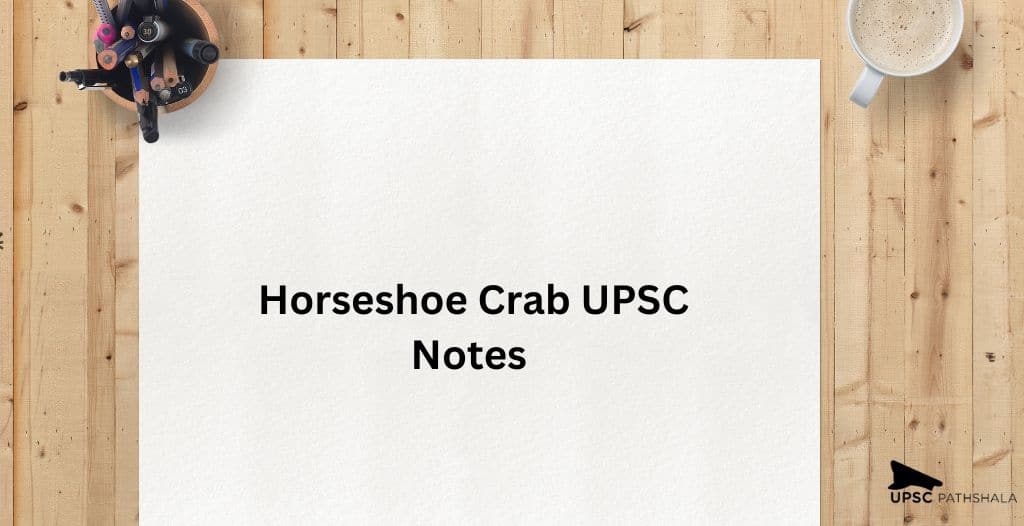The Union Public Service Commission (UPSC) is India’s central recruiting agency for civil services. It is responsible for conducting various exams, including the Civil Services Examination, Indian Forest Service Examination, and others. Aspirants need to prepare well for the UPSC exams to crack them. One of the topics that aspirants must know about is the Horseshoe Crab.
What is Horseshoe Crab?
The Horseshoe Crab is an ancient marine arthropod species that has been in existence for over 450 million years. It is not a true crab but belongs to the arachnid family, and its scientific name is Limulus polyphemus. Horseshoe Crabs are commonly found on the beaches of the eastern coast of North America and the southeast coast of Asia. These crabs are crucial for biomedical research, as their blood contains a chemical called Limulus amebocyte lysate (LAL), which is used to detect bacterial contamination in medical equipment.
Also Read: Digital India Act 2023 UPSC: UPSC Exam Preparation Material
Notes on Horseshoe Crab for UPSC Exam
Aspirants preparing for the UPSC exams should keep in mind the following points related to Horseshoe Crab:
- Habitat: Horseshoe crabs are found in shallow coastal waters and on sandy beaches.
- Anatomy: The horseshoe crab has a hard exoskeleton and a long, pointed tail. It has five pairs of legs and a pair of large compound eyes.
- Reproduction: Horseshoe crabs breed in the spring and summer, and females lay their eggs in the sand.
- Importance: Horseshoe crabs are essential to biomedical research and are used to produce LAL, which is used to detect bacterial contamination in medical equipment.
- Ecological Importance: Horseshoe crabs play a crucial ecological role as they are an essential food source for migratory shorebirds. The eggs laid by female horseshoe crabs provide vital nutrition to these birds during their long-distance migration.
- Threats to Horseshoe Crabs: Habitat loss, overfishing, and pollution are some of the significant threats to horseshoe crab populations worldwide. Habitat loss due to coastal development, dredging, and beach nourishment projects can impact horseshoe crab breeding and nesting areas.
- Conservation Efforts: Several conservation efforts are underway to protect horseshoe crabs and their habitats. These efforts include the establishment of marine protected areas, reduction of fishing pressure, and public awareness campaigns.
- Horseshoe Crab Mating Behavior: During breeding season, male horseshoe crabs follow the pheromones released by females to locate them. When they find a female, they climb onto her back, and the female then moves towards the shore, where she lays her eggs in the sand.
- Horseshoe Crab Blood Harvesting: The harvesting of horseshoe crab blood for biomedical research is a controversial practice, as it can harm horseshoe crab populations. Researchers are working to develop synthetic alternatives to horseshoe crab blood for medical use.
- Horseshoe Crab Fossils: Horseshoe crab fossils have been found in rocks dating back to the Ordovician period, around 450 million years ago. These fossils provide scientists with insights into the evolution of these ancient creatures.
By including these additional points in the notes on Horseshoe Crab for UPSC Exam, aspirants can get a more comprehensive understanding of the topic and be better prepared for questions related to it in the exam.
Also Read: Global Carbon Project UPSC: Notes for UPSC Exam Preparation
Important Facts on Horseshoe Crab
Some of the important facts related to Horseshoe Crab that aspirants should be aware of are:
- Horseshoe crabs have been around for more than 450 million years, making them one of the oldest creatures on earth.
- Horseshoe crabs have blue blood, which is due to the presence of copper in their blood.
- Horseshoe crabs are not true crabs but are more closely related to spiders and scorpions.
- The population of Horseshoe crabs is declining due to habitat loss and overfishing.
How to Prepare for Current Affairs for UPSC Exam?
Preparing for current affairs is crucial for cracking the UPSC exams. Aspirants can follow these tips to prepare for current affairs:
- Read newspapers daily: Aspirants should read newspapers daily to keep up with the latest news and current affairs.
- Watch news channels: Watching news channels can also help aspirants stay up to date with the latest news and current affairs.
- Make notes: Aspirants should make notes of important events and their significance.
- Revise regularly: Regular revision of the notes can help aspirants retain the information better.
How UPSC Pathshala can Help?
UPSC Pathshala is an online platform for UPSC that provides comprehensive coaching and study material to aspirants preparing for the UPSC exams. It offers live online classes, study material, mock tests, and doubt-solving sessions to help aspirants prepare well for the exams. Aspirants can enrol in UPSC Pathshala to get expert guidance and support throughout their preparation journey.
Also Read: Green Hydrogen UPSC: National Green Hydrogen Mission UPSC Notes
Conclusion
In conclusion, the Horseshoe Crab is an important topic that aspirants should be aware of while preparing for the UPSC exams. Aspirants should understand the habitat, anatomy, reproduction, and importance of Horseshoe Crabs to perform well in the exams.
Furthermore, aspirants must stay up to date with current affairs and regularly revise their notes to retain the information better. Enrolling in UPSC Pathshala can provide aspirants with comprehensive coaching and study material to help them prepare well for the exams.







